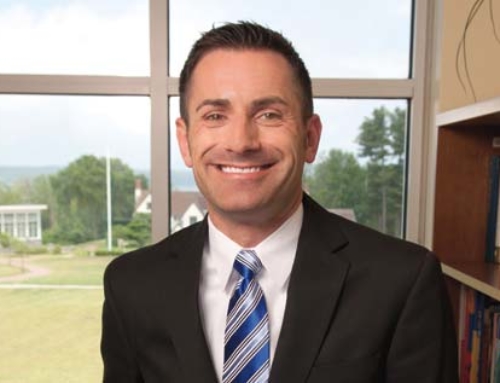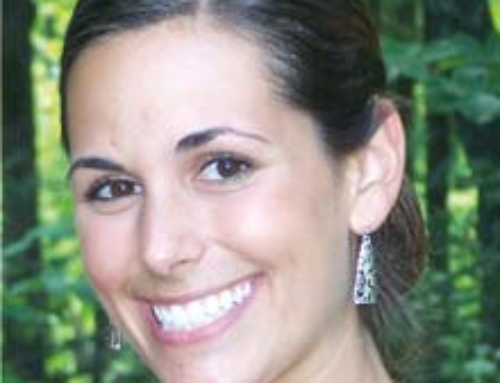 Where horses heal the mind, body and spirit - with help from humans
Where horses heal the mind, body and spirit - with help from humans
Duke, a chestnut quarter horse, maintains a calm steadiness as children and adults with disabilities mount his back to learn to ride at Riding To The Top Therapeutic Riding Center not far from campus. His trustworthy personality has earned him a long-term stay here, and he gets the respect he deserves, almost like a beloved member of the family.
“These are special horses,” says Sarah Bronson, executive director at Riding To The Top (RTT), which serves more than 250 people a year from ages 3 to 80 years old. “They like people, they know who is on their back, they’re intuitive and they’re tolerant,” she adds.
Riders with disabilities learn many things from Duke and his 10 peers at this 50-acre oasis, and not all of it is how to ride. Often they just enjoy being up high in the saddle, being told they can do something.
Saint Joseph’s history major Sara Conant ’14 of Windham, Maine, and riding instructor Angie Craib-Couture ’04 of Oxford, Maine, are a big part of what has made this vibrant, loving community succeed – a committed group of volunteers.
Conant started out helping in the barn seven years ago, then switched over to lessons as a side walker and horse leader (walking next to a horse or leading a horse during the lesson for safety reasons). She also “schools” the horses. For example, a horse might need help with steadying its canter or might need to be coached to stay near the railing. While Conant’s love of horses drew her here, she now she likes “seeing the changes that horses can bring” for children.
Ten years ago while she was a Saint Joseph’s education major, Angie started to volunteer at RTT because she wanted to find a place where she could ride in exchange for doing weekend chores. She signed on as a lesson volunteer and eventually became the barn manager and a nationally certified instructor. She’s been riding her whole life.
“It’s therapy for me,” she says of riding. It’s therapy of a different sort for her students, many of whom have autism, cerebral palsy, Down syndrome, ADD, or developmental delays. For all of these conditions, therapeutic riding can complement occupational and physical therapy goals, as riders unwittingly work on issues of balance, coordination, speech, sequencing, sensory stimulation, strength and safety awareness. Just riding a horse does all that naturally, yet it can be purposeful as well. “If you have a hard time with fine motor skills, you have to learn how to work the buckles to get the saddle to stay on. It’s a huge motivational factor,” says Bronson.
One of Angie’s students is 15-year-old Abby Spiller. They have trained together for seven years, resulting in a genuine bond. They call or text each other, and Abby was a flower girl in her riding instructor’s wedding.
Abby’s mom, Elaine, says, “Angie has a lot of patience. She’s magic with Abby.” She adds, “She can get her to do things.”
Elaine calls Riding To The Top a blessing. Speaking about her daughter, she says, “I’ve seen her grow in so many ways. Physically, there’s so much she can’t do, so it makes her physically stronger and emotionally more confident.”
According to Bronson, teaching a therapeutic riding lesson is like conducting a symphony, because you have to command the attention of horse, rider and volunteers in concert with each other.
These are not pony rides, and students are expected to actively participate. From the center of the ring, Angie gives constant feedback, keeping the riders on task, alert and safe. Safety always comes first. “You’re going a little too fast,” she calls to one rider, who is off-lead, as many are after they reach a certain level of competency.
“Good job, Abby,” she calls out repeatedly to her longstanding student, who has led Duke into a trot. In her other life, Angie is a kindergarten teacher. “I think I’m able to explain things in a way that students understand,” she says.
Though her teaching job is helpful, taking lessons herself helps as well. Her professional development as an equestrian is ongoing, and her students are often surprised that she still takes lessons.
“Angie’s got amazing horse skills and also the ability to teach them,” says Bronson. “She knows the herd incredibly well and has an amazing eye for the horses. She’s good at raising the bar for the riders and has the ability to challenge them safely,” she adds.
Ninety percent of RTT clients have processing issues, so “chatty and abstract” instruction doesn’t work. So while keeping each client’s specific therapeutic goals in mind, instructors need to be clear and set limits. “You have to be literal, and being a taskmaster doesn’t hurt either sometimes,” says Bronson.
Like teaching anywhere, this setting requires thoughtful lesson planning combined with flexibility, because anything can change on any given day. In addition, what works for one client doesn’t always work for another. To explain leg position, sometimes “heels down” works for one client, yet for someone else with a different processing issue, it might be necessary to say “toes up.”
For the children and adults who come here, this is a safe place. Some have tried team sports and been frustrated or rebuffed. Some have no friends, and here they can bond with horses or their peers who have disabilities. Here, they are treated like everyone else.
“Nobody has to explain a child’s behavior at RTT. Parents can let their guard down from a psychological point of view,” says Bronson. “It’s huge for the children to be in control and there’s something about horses. They’ve been our partners through the centuries.”
“A horse can help so many students learn about themselves. Horses demand right now, everything in that moment,” says Angie.
One of the finest moments for Angie is when her clients ride independently for the first time. Cueing a horse to change directions and learning how to post while guiding a horse to trot can represent major accomplishments for her students. But she also applauds the volunteers for the many hours they put in. Though she herself is now paid to teach after many years of volunteering at other tasks, she says, “Without the volunteers, there would be no RTT. I learn from them and they help me learn about my teaching practice,” she notes.
As the goal-oriented part of the lesson winds down, Angie usually ends with a game or a trail ride if the weather is nice. Out on the “sensory trail,” riders find fun-yet-therapeutic stations, like the “forest car wash” where horse and rider must pass through thin, hanging strips of plastic used to help with sensory integration.
Back in the barn at the hour’s end, Abby is helped to dismount and then offers Duke the carrots she brought for him in a small plastic snack bag. Her mother, who has been watching from the parents’ lounge, joins her after the lesson as Duke eats the carrots from his bowl.
With anticipation in her voice, Abby turns to ask, “Mom, are we coming next week?”

